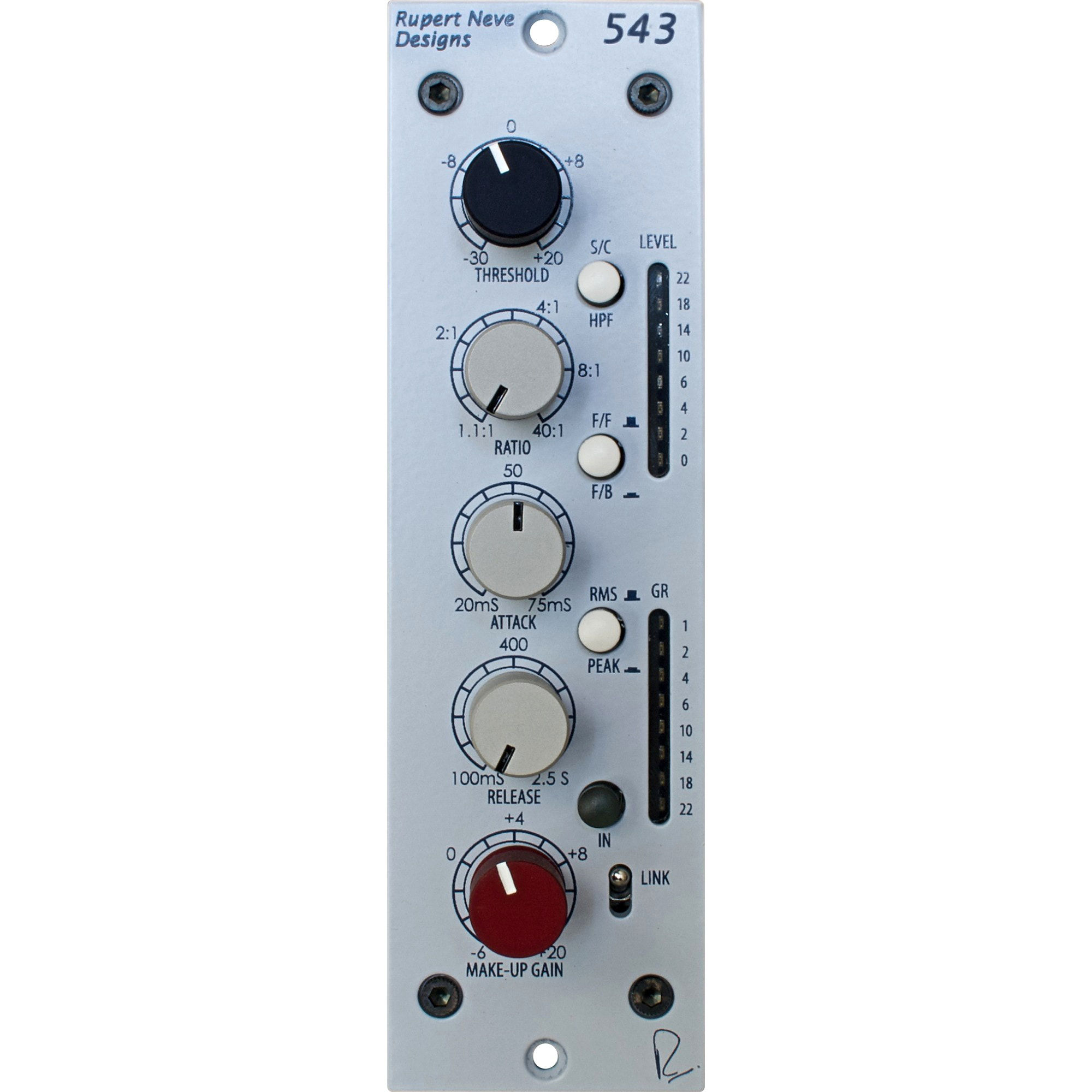The Rupert Neve Designs Portico 543 Mono Compressor delivers the unobtrusive, musical-sounding dynamic control and brick-wall limiting made famous in the Portico 5043 to the 500 series format. The 543 features a fully controllable compressor-limiter with feed-forward / feedback modes, Peak / RMS detection and a built-in sidechain high pass filter.
Built around Mr. Rupert Neve's custom transformer designs, each 543 module encompasses individually controllable threshold, attack, release, makeup gain, ratio, side chain HPF, Feed-Forward / Feed-back selection and Peak/RMS detection modes. With the compressor inactive, the 543 may be used as a transformer-coupled, high-performance line amplifier, and two 543 may be linked for stereo operation as well.
Low-Distortion V.C.A.
The Portico 543 makes use of a very accurate, low-noise, low-distortion V.C.A. having, essentially, no signature of its own. A part of the audio signal is rectified and smoothed to produce a suitable control voltage for the V.C.A. which has to respond very quickly and have low distortion. If the response is too fast, low frequency signals will themselves, be gain controlled! If the response is too slow, the signal will overshoot and the first few cycles will not get compressed. The speed and accuracy of the response, known as the "attack", and the time frame that gain remains under the initial control, known as "release" or "recovery" and plays a large part in the way a compressor sounds.
Feed-Forward or Feed-Back?
The 543 also has the ability to switch between feed-forward and feed-back modes. If the V.C.A. Control voltage is taken from the 543 output, (i.e. after the V.C.A.) it cannot act immediately on the V.C.A. because it has already been modified by settings of the V.C.A. and circuits through which it has passed. This is known as a "Feed-Back" compressor.
RMS or Peak?
One of the more unique features of the 543 is the new Peak / RMS mode. This switch allows the VCA to respond to both RMS and peak levels. RMS circuits are considered to better mimic the way the ears perceive apparent loudness. In this case, peak mode uses a combination of both methods to get the best of both worlds, and avoids the drawbacks of each method on its own.
Ratio and Threshold
Above a given "THRESHOLD" signals are reduced by an adjustable amount ranging from 1:1, (which is linear, or no reduction at all), to more than 40:1. RATIO is sometimes referred to as "Slope" because when depicted on a graph, the slope of the graph representing output versus input, is what changes. Ratio and Threshold are closely inter-dependent. If a RATIO as high as 40:1 has been set, and if the THRESHOLD is set at 0dBu, even when a massive signal of +40 dBu (unlikely!) is presented to the input, the output signal will only be +1 dBu. RATIOS as high as this would normally be set somewhere above 0dBu - say at +14dBu, in order to prevent the output signal level exceeding just over +14 dBu to protect, for example, a digital recorder. Similarly, if a RATIO of 5:1 has been set, an input signal which is 10dB above THRESHOLD will only rise by 2dB above that THRESHOLD at the output.THRESHOLD control covers the Range from below -30dB to +22dBu. When THRESHOLD set at a low level, with a fairly high RATIO the amount of gain reduction will be considerable and it may be necessary to use some GAIN after the compressor to restore the apparent signal level.
Attack Time
The ATTACK time is the time taken for the compression circuits to start compressing. A long ATTACK time allows short duration peaks to "escape" and go through uncompressed. This may cause overload on subsequent digital circuits. A very short attack time sounds un-natural and robs the signal of "life" by removing transients. Some transients are extremely fast and have little effect on the sound quality.
Release / Recovery
The way in which a compressor deals with actual program material depends upon the magnitude and duration of peaks in the program level. If the RELEASE TIME is set to be very short, a short duration signal will be compressed but the gain will return to normal very quickly, giving a fluctuating and un-natural sound known as "Pumping".
Compression
For signals below the "threshold" level that has been set, a compressor provides a linear path allowing signals to be amplified without the gain being adjusted in any way. When signals exceed the "threshold" level, the gain is reduced in a controlled manner that depends on the Ratio that has been set.
Gain
The GAIN range provided is from -6dB to +20 dB. As already noted, when compression has taken place, it may be necessary to increase the overall gain to restore the apparent program level
Peak
When engaged, the 543 uses a combination of peak and RMS (average) detection to determine level. When disengaged, it follows just RMS.
Side Chain High-Pass Filter
Introduces a HPF at 250Hz to the VCA side chain signal. This allows the compressor to disregard sustained low frequency content.
Ratio
Range from 1:1 to LIMIT (i.e. 40:1)
Threshold
Range from -30dBu to +20dBU
Attack Time
Range from 20mS to 75mS.
Release / Recovery Time
Range of RELEASE time is 100mS to 2.5Seconds.
Stereo Operation
When the LINK switch is engaged on two 543 modules and settings are approximately the same values, GAIN reduction on both channels will be the same to preserve stereo balance and position.
Ducking
When the LINK switch is engaged on two connected 543 modules, the signal passing through the first module may be used to control the amplitude of a second module.
Meters
Two Peak LED METERS are provided that show OUTPUT LEVEL and GAIN REDUCTION.
Rupert Neve Designs 543 Portico Compressor
- Fully controllable compressor-limiter with feed-forward / feedback modes, Peak / RMS detection and a built in side chain high pass filter.
- Sidechain high-pass filter at 250Hz to the VCA sidechain signal - lets bass through without dragging down mix
- 8-segment LED meter for monitoring output level
- 8-segment LED meter for monitoring gain reduction
- FF/FB button changes the detection from feed-forward to feedback
- RMS/Peak button changes the VCA detection from RMS (average) to a peak-RMS hybrid
- Link switch engages link bus for stereo operation of two Portico 543s
- Gain range: Continuously variable from 6dB to +20dB
- Threshold range: Continuously variable from 36dB to +22dB
- Ratio range: Continuously variable from 1.1:1 to Limit (40:1)
- Attack range: Continuously variable from 20mS to 75mS
- Release range: Continuously variable from 100mS to 2.5 Seconds
- FF/FB: Feed-Forward or Feedback VCA control
- Maximum output level (balanced and floating transformer output maximum output from 20Hz to 40kHz) +23 dbu

.jpg)

